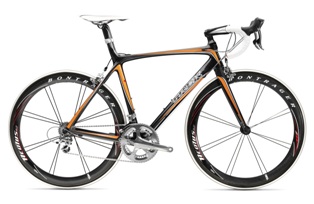
Equipment and Apparel
Equipment
Apparel
Accessories
One obvious piece of equipment that you'll need to get your start in road biking is a road bike. Now that may seem simple enough, but it should be a complicated process if you want to get a good fit and use the bike to its fullest potential. Thereís not just one type of road bike either. There are racing road bikes and touring road bikes. You can race with a touring bike, but you'll have to work a little harder to keep up. I own a touring road bike. The differences between the two are:
- Racing Road Bike:
- Two cogs on front gear
- Usually only 18 speeds
- More compact frame
- Touring Road Bike:
- Three cogs on front gear
- Usually 24 speeds
- More comfortable frame
There are probably hundreds of road bike manufactures in the world. Some of them mass produce bikes in a few different sizes and some custom fit bikes to your specifications. As you can probably guess the custom bikes are much more expensive then a mass produced bike is. Custom made bike are for those who are either very serious about cycling or those who have a lot of money to spend. My two favorite bike manufactures are Specialized and Trek. I own a Trek 1500 road bike and a Specialized Rock Hopper mountain bike. Here are a few of the larger, high-quality bike manufacturers in the world.
- Giant
- Cannondale
- Bianchi
- Schwinn
- Orbea
The list goes on and on.
After you find a bike and have it fitted to you by a bike shop expert there are some other things that will help you ride more comfortably.
Cyclist get a bad rap much of the time because of the clothes they wear (and the fact that most the men shave their legs), but there is a reason they dress like they do. Hereís a list of the basic cycling apparel and why it helps you ride better.
- Jersey and Shorts (also called a kit when the two match each other)
- Helps keep the rider cool by wicking away moisture from the body.
- Reduces wind resistance. Believe it or not but this saves not only time in a race but a lot of energy (a head wind is the most depressing thing on a bike ride). Side note: cyclist do not shave there legs to save time, they do it to reduce road rash in the event of a crash.
- A quality jerseys and shorts are cut to reduce chaffing.
- Bright jerseys keep the rider safe when riding around town.
- Jerseys and shorts just look good. Now days they have jerseys with everything from your favorite band to argyle patterns on them.
- Socks
- Thin, so shoes will fit tight and not slide around.
- Keep feet cool.
- Gloves
- Full fingered keep fingers warm on cool days.
- Padded palms to prevent numbness in the fingers on long rides.
- Can protect the riderís hands in a crash.
- Helmet Ė the most important part
- Protects the rider in a crash.
- Many slits in the top to keep rider cool.
- Helmets with visors keep the sun out of the riderís eyes.
Once you have your kit together then itís time to accessorize. So next weíll look at some of the odds and ends type of apparel that the avid cyclist must have.
- Sunglasses - Not only keeps the sun out of the riderís eyes but keeps the wind out too. Some glasses have interchangeable lenses that include a dark lens, an orange/yellow lens, and a clear lens.
- Heart Rate Monitor/Watch - Keeps you from working too hard or not hard enough while riding, but more about that on the other page.
- Shoes - Clip in shoes are a must. They keep you attached to the bike allowing you to use two motions to pedal as opposed to only one (an up pedal and a down pedal).
- Arm and Leg Warmers - These are great for those days that either start cold and end warm or start warm and end cold. Itís like having a jersey with detachable sleeves.
- Cyclocomputer - A very basic Cyclocomputer will tell you speed, average speed, max speed, distance, ride time, and lifetime distance of the bike. A little more high-tech of a computer will tell you all of that and your power in watts, cadence, calories burned, and heart rate.
Back to Top
Home
Training
